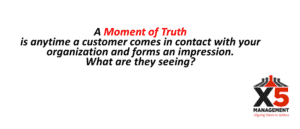Many organizations and their sales and service teams lose valuable time due to the common interruptions and distractions that exist in today’s fast-paced, information-driven business world. Have you identified the specific tasks and high-priority items for each individual involved in a sales or customer service role? That’s where the Priority Matrix comes in.
What is the Priority Matrix?
Often associated with project management, the Priority Matrix is a matrix (often software) that helps identify tasks and their priority. We often reference this tool in training courses to help participants spot important and urgent tasks versus unimportant and non-urgent tasks. It also enables individuals to quickly find those critical areas of focus for weekly scheduling.
Ultimately, it helps cut distractions and interruptions that can be costly to an organization’s productivity.
In a world where multitasking is almost as natural as breathing, it’s not uncommon to feel like one is constantly working on something, but never really making any progress. As a leader, this can be particularly frustrating when a team is struggling to be productive.
But the truth is, without prioritizing certain tasks, it’s tough to effectively cross things off a list. And when it comes to workplace productivity, multitasking can be a killer.
Instead, prioritizing key tasks can make a world of difference. That is why the Priority Matrix should be mastered!
The Four Areas of the Priority Matrix
The Priority Matrix is divided into four areas. Within each of these areas, individuals are encouraged to identify the priority level of each task they may have. This allows them to identify exactly which tasks need immediate attention and which tasks can wait.
Take a look at the four areas of the priority matrix below to give you more insight into how these areas affect your organization:
1: High Importance and High Urgency
This is the red zone! These items must be solved immediately and efficiently. Urgent customer issues and sales proposals with an upcoming deadline fit well within this category. As these items arise, priorities in the other three areas will take a back seat.
Speaking of urgent customer issues, take a look at this post next: 4 Ways Difficult Customers Are an Asset to Your Business.
2: High Importance and Low Urgency
Although it’s not necessary to complete these immediately, these sales and service-related tasks are critical to continued success and growth. Continued sales and servicing existing customers keep your organization in business.
This category includes carving out time for continued business development activity or prospecting.
3: Low Importance and High Urgency
We encourage individuals to try and limit time in this area. What may seem highly urgent to some may not be important to your sales goals or the health of the organization. Common workplace distractions and interruptions fit well within this category.
These are good examples of projects to delegate to employees or emerging leaders who may need to develop a skill set. Follow-up will be critical.
4: Low Importance and Low Urgency
Consider this area as your “stop doing” list! Any activity that fits within this category is not providing you or the organization value. Time lost in this category due to common distractions is costly to the growth of the individual and the organization. These are likely projects that have been talked about however they never become recognized as valuable, and if that is the case, elimination is the best solution.
How to Use the Priority Matrix
Every project starts with an objective. Once you’ve established your objective, decide which of the above areas it falls into. Every product, service, or solution starts with a problem it aims to solve. And every prioritization matrix begins with a set of criteria to rate your solutions or items against. Tracking these is key and once the first round of criteria is discussed, and expected outcomes are agreed upon, it is common to move some projects around based on newly recognized priorities. Not everything can be in the Red Zone (High Importance and High Urgency).
Using an up-to-date visual is an effective tool, especially for a team who all need to know and agree on where a project falls in a priority area. Out of sight can become out of mind, so having this posted or sharing an online version will be helpful. Each team member must understand how their contribution to a project fits into the whole, and follow through on the appropriate area of importance and urgency.
The Benefits of Using the Priority Matrix
There is always an advantage of a fast-moving and busy sales or service team working together with the same priorities. This is especially true when it comes to time frame and scope. The team can decide, discuss, and debate the four areas of priority before getting started, which avoids internal factors that often lead to delays, such as poor or minimal communication. This process creates the sense of urgency required to finish a project on time.
The beauty of using a Priority Matrix is it keeps things simple by focusing on two factors – urgency and importance. Regardless of what environment we work in, sometimes everything seems urgent and we become overwhelmed by what we perceive to be competing priorities. If you, as a business or sales leader, are overwhelmed, imagine the team around you.
Time management and teamwork are some of the areas we hear about from clients and prospects. If managed and executed effectively, and consistently, the Priority Matrix is a tool that helps address these challenges. It is also a tool X5 Management uses in one-on-one leadership and sales coaching to ensure effective habits are created for more ideal performance.





